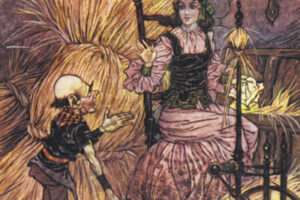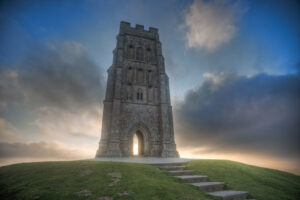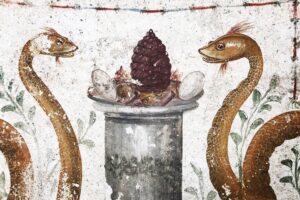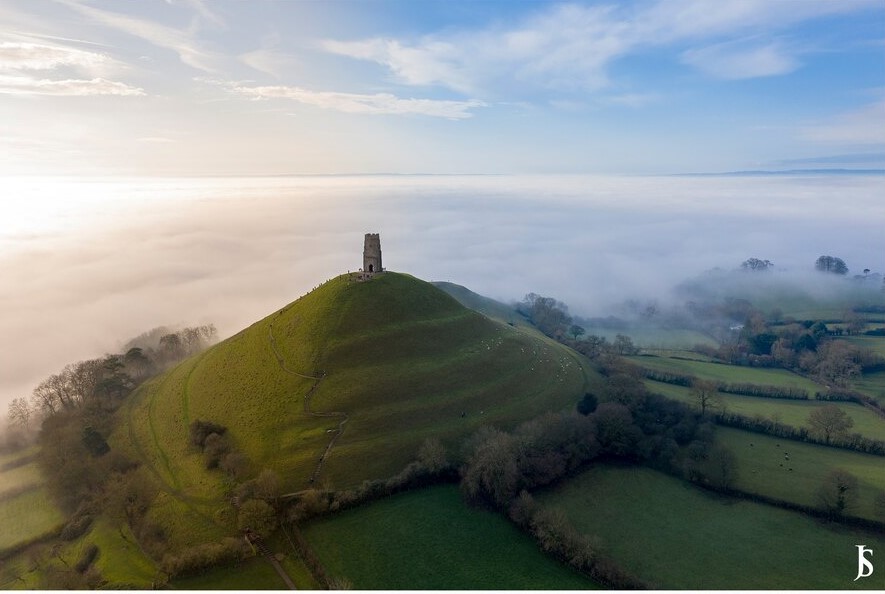
The island of Avalon, between history and legend
The island of Avalon, between history and legend
by Hasan Andrea Abou Saida
Apart from legend and myth, historical sources regarding the actual existence of Avalon are scarce. On the other hand, no finds or artefacts have ever been found referring to, or belonging to, the people of Avalon or the island itself, at least as far as we know. But let us proceed in order. To know what Avalon really is, we must start with the meaning of its name. The name “Avalon” originates etymologically from the ancient Cornish and Breton languages. In modern Welsh the island is called “Ynys Afallon” or “Ynys Afallach” which literally means “apple island”, but the word “ynys” can also be translated as “realm” or “kingdom”. On the other hand, the word “Afall” meaning “apple” with the addition of the plural ending “ach” means “the orchard” or even “the apple trees”. In the old Breton language, the word “apple” was “aval” or “avalou” in the plural. The Old English word for apple, “apple”, is derived from the Old English “æppel”, which comes from the Proto-Germanic word *ap(a)laz, which in turn comes from the Indo-European root word *ab(e)l, *h₂ébl̥, *h₂ebōl, meaning apple, apple tree, or a fruit in general. Words derived from this Indo-European root are found in Celtic, Germanic, Baltic, Slavic and Italic languages. It is immediately apparent that this fruit, the apple, represents an archaic element common to Indo-European peoples and of fundamental importance for understanding the soul of Avalon. Since the earliest times of mankind, the apple has been a universal symbol rich in meaning: it represents knowledge, beauty, divine harmony and even immortality 1. In ancient Indo-European mythologies, the apple tree was associated with the Great Goddess, who was called in different cultures in many ways such as White Goddess, Anu, Dana, the Great Mother, etc. From this sacred tree, the Celts produced mead, ‘the drink of the Gods’, which they used during ritual festivals throughout the year, especially during the sabbath of Samhain, the Celtic New Year which took place between 31 October and 1 November. Again according to the author Riccardo Taraglio 2, in the source he cites in his book and called ‘Audience of the Doctors’, it is reported that the apple tree was the shelter of the White or Wild Hind, one of the animal manifestations of the Goddess and representing the feminine principle. The Great Goddess was also worshipped in her triple aspect, the Triple Goddess, as for example in Indo-European cultures were the Greek Moise, the Roman Graces and Fates, the Nordic Norns and the three aspects of the Hindu goddess Mahadevi. In particular, the best-known personifications of the Great Goddess Trina in the Irish pantheon are: the triple goddess Morrigan, associated with fate, death and war, composed of the virgin Ana, goddess of fertility, her mother Babd, she who perpetually produces life through the boiling of a cauldron, and the goddess of time Macha the Elder, the great goddess of ghosts or Mother of Death, and the triple goddess Brigid, daughter of Morrigan and Dadga, a goddess associated with light and solar energy. Brigid’s aspects are connected to the energy of fire, which governs her three functions as patroness of poetry, patroness of healing and fertility, and patroness of blacksmiths and the martial arts. The folklorist Robert Graves describes these three characteristic aspects of the White Goddess 3: The Young, The Mother and The Old, which reflect the cycle of life (birth, life, death) and the phases of the Moon (new, full and waning) 1. In ancient Indo-European mythologies, the apple tree was associated with the Great Goddess, who was called in different cultures in many ways such as White Goddess, Anu, Dana, the Great Mother, etc. From this sacred tree, the Celts produced mead, ‘the drink of the Gods’, which they used during ritual festivals throughout the year, especially during the sabbath of Samhain, the Celtic New Year which took place between 31 October and 1 November. According to the author Riccardo Taraglio 2, in the source he cites in his book and called the ‘Audience of the Doctors’, it is reported that the apple tree was the refuge of the White or Wild Hunt, one of the animal manifestations of the Goddess and representing the feminine principle. The Great Goddess was also worshipped in her triple aspect, the Triple Goddess, as for example in Indo-European cultures were the Greek Moise, the Roman Graces and Fates, the Nordic Norns and the three aspects of the Hindu goddess Mahadevi. In particular, the best-known personifications of the Great Goddess Trina in the Irish pantheon are: the triple goddess Morrigan, associated with fate, death and war, composed of the virgin Ana, goddess of fertility, her mother Babd, she who perpetually produces life through the boiling of a cauldron, and the goddess of time Macha the Elder, the great goddess of ghosts or Mother of Death, and the triple goddess Brigid, daughter of Morrigan and Dadga, a goddess associated with light and solar energy. Brigid’s aspects are connected to the energy of fire, which governs her three functions as patroness of poetry, patroness of healing and fertility, and patroness of blacksmiths and the martial arts. The folklorist Robert Graves describes these three characteristic aspects of the White Goddess 3: the Young, the Mother and the Old, which reflect the cycle of life (birth, life, death) and the phases of the Moon (new, full and waning).

Returning to the apple and its meanings, it can be noted that in the initiatory journeys to the Celtic Otherworld there is always the presence of the apple fruit. In an Irish legend, for example, it is said that the warrior poet Oisin, son of Fionn Mac Cumhaill, saw a beautiful maiden named Niamh holding a golden apple in her hand, while she was riding a black horse, offering the hero knowledge and immortality 4. A branch of a silver apple tree with white flowers from the island of Emain Ablach, also known as “Emain of Apples”, is the talisman that the White Goddess offers Bran when he enters the Land of Youth, and a thrown apple is the gift that a fairy maiden gives Condla, son of Conn Cetchathach, before disappearing into the Otherworld 5. In Irish texts, the Otherworld is seen as a land of immortality, where time flows in a different way, and where heroes live for centuries without even feeling the passage of time, but when they return to their homeland, when they get off the ship or horse and touch the ground, they turn to dust.
The connections between the sacred feminine, the apple as a vehicle of knowledge and the Altromondo for the Celtic tradition totally reflect the teachings of wisdom present in Avalon. The apple is not only a symbol of knowledge, but also of transformation and rebirth in connection with the inner sacred feminine. However, the initiatory journey of a warrior or knight to Avalon is not only an inner journey and a challenge to achieve soul immortality, but also a journey to a sacred place that really existed.
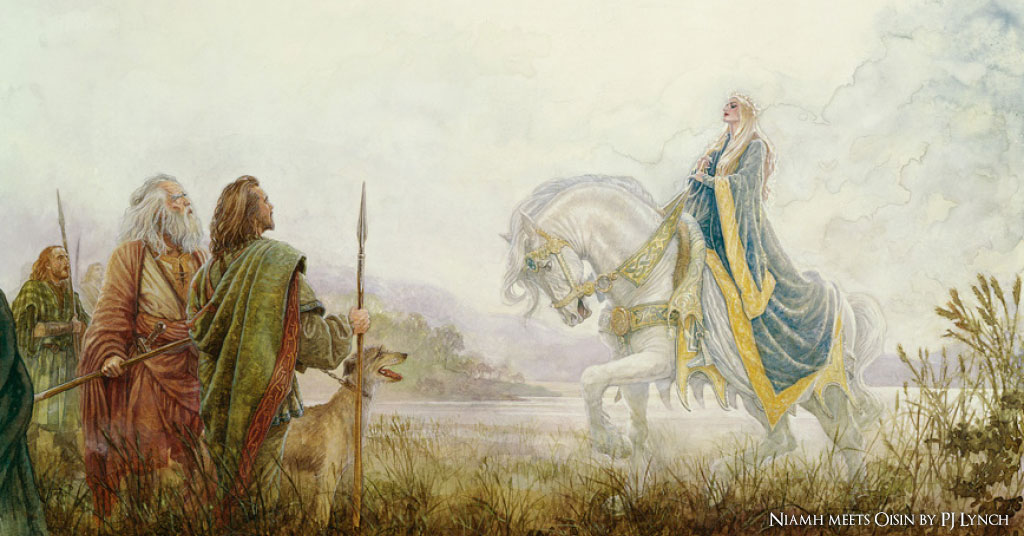
Irish tradition tells of a Garden to the East of the world, “Gard na-hIsbéirne” or the Garden of the Isles of Isbèrne, the place where one of the labours of the sons of Tuireann took place: they had to appropriate the golden apples of that garden. The undertaking was not easy and Brian, the elder brother, said that the best thing to do was to act swiftly in the form of a swift hawk, enter the garden, take possession of the apples and flee as soon as possible. Guarding the garden were the three eldest daughters of the king of Isberne, women of great wisdom who transformed themselves into three griffins with sharp claws 6. Exactly as in other myths related to a garden located in a distant place full of apple trees, there is the presence of a female guardian and initiator at the same time.
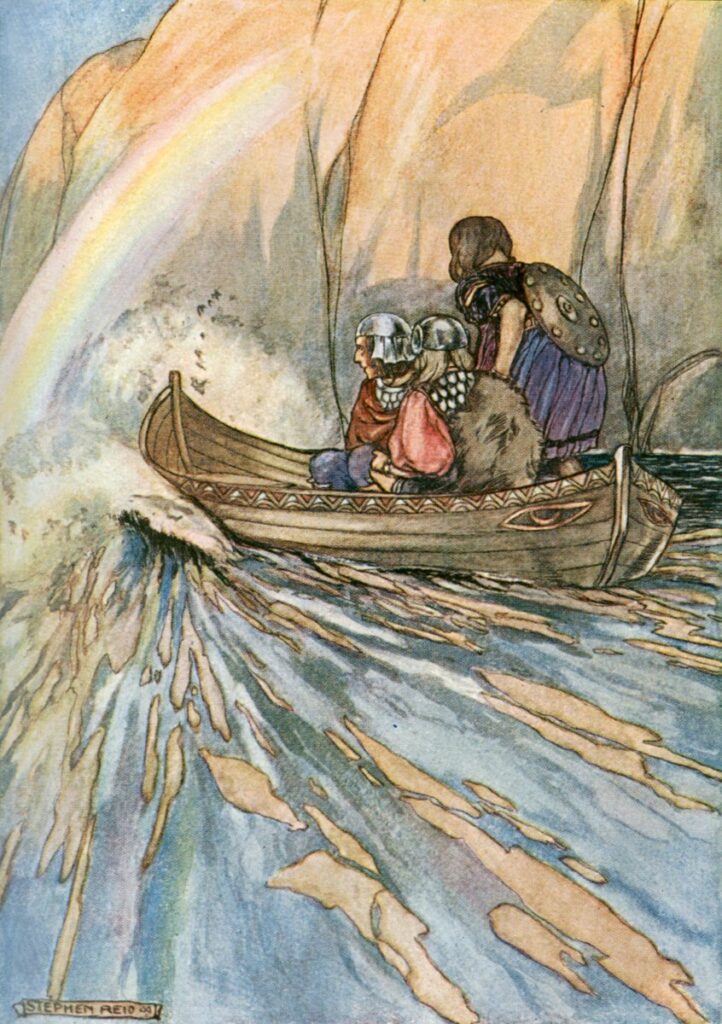
We can therefore deduce that Avalon is referred to by many other names in Indo-European mythology, but all these places refer to a single place, an island of infinite wisdom where only the worthy and pure of heart can enter, after passing through its mists, the Mysteries. But is this just an allegory, an inner dimension, or did this island really exist? It is necessary to take a step backwards and retrace the historical origins of the Avalonian myth to find further answers.
The first author to refer to Avalon in his writings is Gottfried of Monmouth, a Welsh historian, writer and Benedictine monk who lived in the 12th century. Gottfried mentions this magical land in two of his works in Latin: the first work, written in 1136 under the title ‘Historia Regum Britanniae’ (History of the Kings of Britain), is a highly successful medieval chronicle that traces the history of the British kings over a period of 2000 years, starting with the landing of Aeneas’ nephew Brutus in Britain in 1240 BC, and ending in 597 AD with the barbarization of the island by the Saxons and tyrant kings.
In this writing, King Arthur, in order to recover from his wounds after fighting with Mordred, goes to a place called ‘Insula Avallonis’, or Isle of Avalon. According to Celtic traditions, King Arthur did not actually die on Avalon, but will one day return to lead his people against their enemies 7. Furthermore, the Benedictine monk tells us that Avalon is the place where the legendary sword Excalibur was forged.
In his next work, “Vitae Merlini” (Life of Merlin), dated around 1150, Goffredo reveals more details about Avalon, calling it ‘Insula Pomorum’, ‘the Island of Apples’, and adds:
“The Isle of Pomes is also called Lucky Isle because it produces all goods by itself. It does not need the fields to be ploughed by peasants: it knows no cultivation except the spontaneous work of nature. It therefore offers abundant harvests, grapes and fruit born from the shoots that sprout in the woods. One lives a century and more there. In that place nine sisters happily govern those who join them from our lands. Most of them perfect themselves in the medical arts and stand out among the others for their rare beauty: her name is Morgana and she has studied the properties of individual herbs to cure the sick. She is also known for the art of transforming herself and soaring through the sky, like Daedalus, sprouting wings. Whenever she wants, she is in Brest, Chartres or Pavia, or descends from the sky over our regions. They say that he taught astrology to his sisters: Moron, Mazoe, Gilitena, Glitone, Tirone, Titena and Titone, a very famous zither player. On this island we transported King Arthur, seriously wounded after the battle of Camblan, led by Barindo, a profound connoisseur of the sea and the stars. With him at the helm of the ship, we landed on the island together with the king, and Morgana welcomed us with due honours 8”
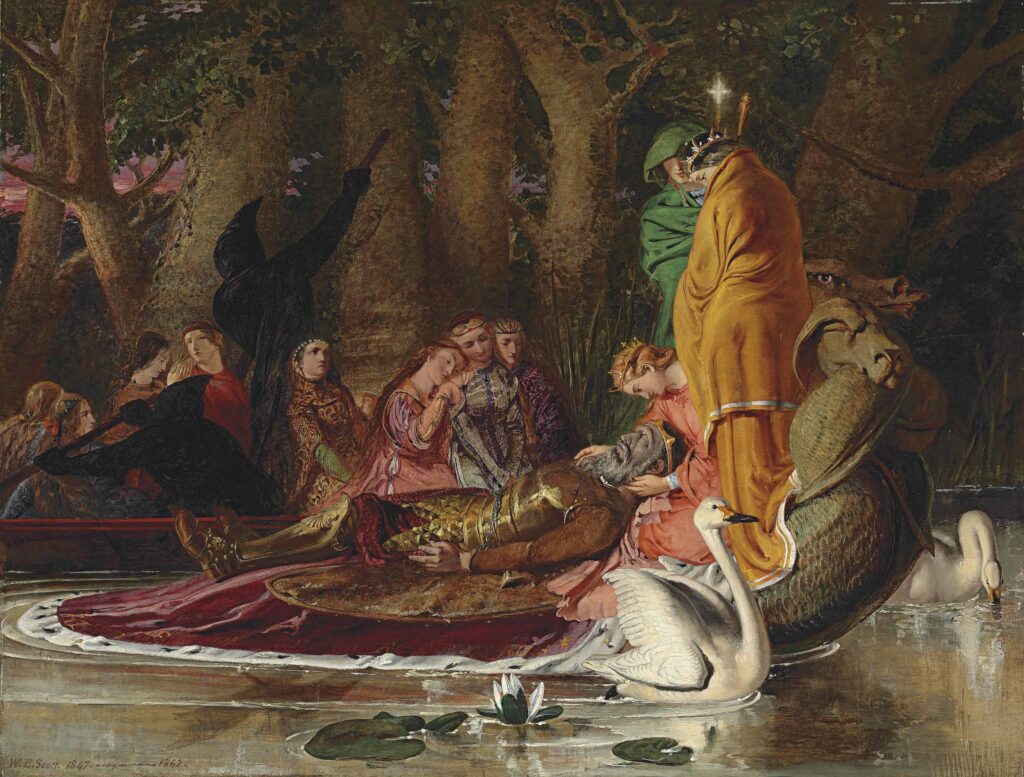
With this passage, Goffredo confirms that the Fortunate Islands, or simply Fortunate Island, coincide with the Isle of Avalon. He also describes nine healing sisters led by the high priestess Morgana 9, just like the nine priestesses described by the geographer and writer Pomponius Mela, who were able to transform themselves into animals, heal incurable wounds, move the winds and the sea, and predict the future for sailors. Let us read more specifically from the Greek geographer:
“Sena, in the British sea, opposite the coast, near the Osismii, is noteworthy for the oracle of the Gallic deity whose priestesses, it is said, are nine perpetual virgins. They are called Gallisenae; they claim to calm the stormy seas and the winds with their songs and peculiar tricks, and to transform themselves into any animal. They know how to heal what others cannot heal and how to foretell the future 10”
This heavenly myth finds its sources and similarity in ancient Norse writings, which describe idyllic places such as the Irish island Tìr Na nÓg 11, known as the Land of Youth, Tir na mBan12, the Land of Women, Tir na mBeo 13, the Land of the Living, the Land Annwfn 14, the underworld in Welsh mythology. More akin still appears Emain Ablach15, the Welsh Land of Apples, over which, according to the medieval poem “Baile Suthain Sith Eamhna”, the god Lug Lamfada reigns.
The real existence of this ancient island of wisdom and knowledge could be found in a territory that has now disappeared, the original homeland of the Indo-Europeans in the North Sea called Doggerland. Around 12,000 BC, this part of the European continent linked Britain to Germany and Scandinavia, forming one large country connected to Europe: both the North Sea and most of the British Isles were totally covered by ice, and the Rhine River flowed north through this land. According to digital landscape reconstructions by a team of expert archaeologists from the University of Birmingham, around 8000 BC the continent was full of rolling hills, wooded valleys, marshes and lagoons – a veritable Garden of Eden 16. Summer and autumn were supposed to be times of plenty of wild animals to hunt, fish in the sea and wild fruits such as berries and nuts. But around 8200 years ago, after the sea level had been rising slowly and steadily for millennia, the immense Lake Agassiz poured a huge influx of fresh water into the Tyrell Sea, changing the course of ocean currents, especially the Gulf Stream, and causing temperatures to plummet. Glacial winds began to form, affecting the northern hemisphere, including the now largely submerged Doggerland continent. But it was the so-called ‘Storegga Tsunami’, a huge wave caused by three landslide events of a massive ice mass on the coast of Norway (Storegga Slide), which swept over the coast of northern Europe, swallowing the last piece of Doggerland into the North Sea, that caused the total sinking of the country around 6100 BC.

The Doggerland civilisation, due to rising sea levels and subsequent catastrophic events, was forced to migrate south and east, to more temperate climates rich in vegetation and fauna, clashing and fighting with the other indigenous peoples of Old Europe, looking for a new homeland, taking with them the memory of the lost homeland in their myths and legends, a very fertile land rich in vegetation and fauna that sank into the North Sea, and which we now know from legends as Avalon.
1 This refers in particular to the wild apple tree, which is more common in the British Isles than the traditional apple tree.
2 Riccardo Taraglio is an expert on Celtic culture and director of “Celtica”, the festival dedicated to the Celts, and author of the book “Il vischio e la quercia” (The Mistletoe and the Oak), the most complete and in-depth essay in Italy on Celtic tradition and spirituality. Taraglio, R. (2005). Il vischio e la quercia : la spiritualità celtica nell’Europa druidica (Nuova). Torino: L’età dell’acquario.
3 In his essay ‘The White Goddess’ Graves proposes the idea of the existence, in ancient and archaic times, of a single European divinity, the so-called ‘White Goddess’, mistress and master of love and death, connected to the phases of the moon and very similar to the Mother Goddess of matriarchy.
Graves, R. (2009). La dea bianca : grammatica storica del mito poetico (Seconda). Milano: Gli Adelphi.
4 Cataldi, M. (1985). Antiche storie e fiabe irlandesi. Milano: Einaudi.
5 Taraglio, R. (2005). Il vischio e la quercia : la spiritualità celtica nell’Europa druidica (Nuova). Torino: L’età dell’acquario, pag. 309.
6 This feat is one of the labours required by the god Lug to recover powerful magical objects as the price of reparation for the murder of Cían mac Dían Cécht, son of Dían Cécht, killed at the hands of Brian mac Tuirenn and his two brothers. Similarly, the labours of the sons of Tuirell resemble the labours of the semi-Greek god Heracles. Heracles himself submits to the twelve labours to atone for a crime he has committed and travels to remote places, looking for wonderful objects and animals with strange virtues, in search of immortality, just like the sons of Tuirell. Il Destino dei figli di Tuirell, Le mele d’oro del Giardino di Isbérne, https://bifrost.it/CELTI/6.TuathaDeDanann/09-DestinodeiFiglidiTuirell.html (last visit 21/05/2020).
7 For the Welsh, the island of Ynys Affallach, better known as Avalon, is the place where souls went after death, the same place where wounded Arthur took refuge.
8 Geoffrey di Monmouth (1993). La follia del mago Merlino; a cura di Alberto Magnani. Palermo: Sallerio Editore, pagg. 84-85.
9 In the Arthurian cycle Morgana is a powerful sorceress and half-sister of King Arthur, daughter of Igraine and Duke Gorlois of Cornwall. Called by many names such as Morgen, Morghe, Morge, Morgue, Morgain, Morgan can be symbolically associated with the Irish goddess Morrigan, the “Great Queen” (Mor-: great / Rigain-: queen), who has the ability to transfigure her form into any animal, often appearing in the guise of a bird, a raven, a crow, a snake or sometimes a she-wolf. Other scholars, however, associate Morgana with the Welsh goddess Modron, the equivalent of the Gallic goddess Matrona. In contrast to Arthur, who represents life, Morgana is the goddess of fate and death.
10 Pomponio Mela (1855). Geografia. Libri tre tradotti e illustrati da Giovanni Francesco Muratori. Torino: Della Stamperia Reale, pag. 161.
11 It is the Otherworld for Irish mythology, where the Túatha Dé Danann settled when they left the surface of Ireland and was visited by some of Ireland’s greatest heroes.
12 Island populated only by beautiful women and which was half of some heroes like Máel Dúin in ‘Imram Curaig Maíle Dúin’ (Journey of Máel Dúin). The women on the island offer a companion for every male visitor and serve only the best cuisine with the most enchanting music. The hero Bran mac Febail was summoned by the queen of Tir na mBan and stayed on the island for many years, thinking that only one year had passed.
13 The land of the living, it is a place of eternal life, one of many distant lands.
14 It is the underworld in Welsh mythology, ruled by Arawn, god of hunting and seasonal cycles. Annwn is described as a geographical place in the west and almost unreachable, a land of delights and eternal youth where disease is absent and food is always plentiful. Annwn, however, can also be visited by the living if they are able to find the door, which would be hidden at the mouth of the River Severn.
15 It is the mythical island paradise of Irish mythology, the realm of the sea god Manannan mac Lir and identified with the Isle of Man or the Isle of Arran.
16 Gaffney, Vince & Thomson, Kenneth & Fitch, Simon. (2007). Mapping Doggerland: The Mesolithic Landscapes of the Southern North Sea.
Bibliography
Un viaggio ad Avalon – Aindreas Fàél (2020). Sossano: Anguana Edizioni

